NO MORE Slimy Veggies-NO KIDDING!
Oh, do I have a story for you! But first, please know I have NO affiliation or vested interest whatsoever with what I'm about to share. I'm passing this on because I think you'll appreciate knowing it.
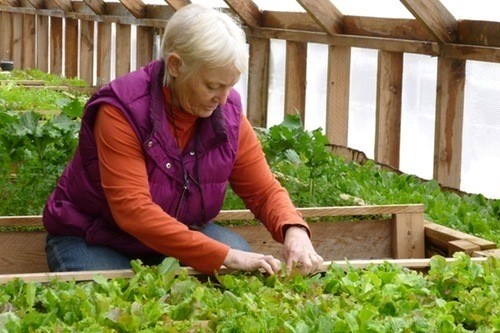
It starts with salad lover, Sally Erickson. She moved to Eastport, Maine, where she designed and built a solar greenhouse so she could grow and sell her greens, and to also be able to feed her salad habit year-round.
When harvest time arrived the first winter, she refused to insult her beautiful greens by selling them in plastic bags. (Too many fresh vegetables turn to brown slime when stored in plastic.) Extensive research revealed a salad lover's secret: humidity-loving vegetables don't rot in damp cloth! (I didn't know this.)
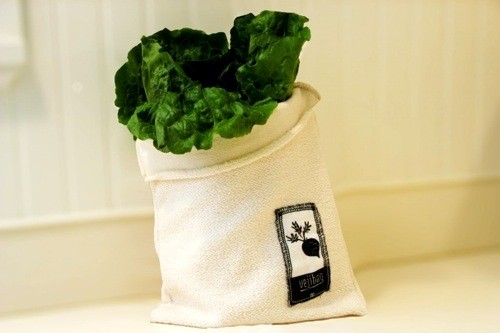
So she prototyped a fabric bag to pack her greens in. Sure enough, it worked. It was the end of rotten vegetables.
And the local food community in tiny Eastport jumped on board. It just made sense: no more slimy or wilted vegetables; no more wasted plastic. Within weeks, reusable, returnable bags became the new normal. The next step was a no-brainer:
Rally a group of creative, gutsy and seriously cool women and start a think tank to see how far such a wild idea could go. Radical concepts started to fly around the room, and six stuck like glue:
- Let's create a vibrant local economy!
- Let's insist on a healthy local and global environment!
- Let's pay women well to work flex time at home!
- Let's start a cottage industry!
- Let's get everyone eating more salad!
- Let's start the transformation, right here in our little town!
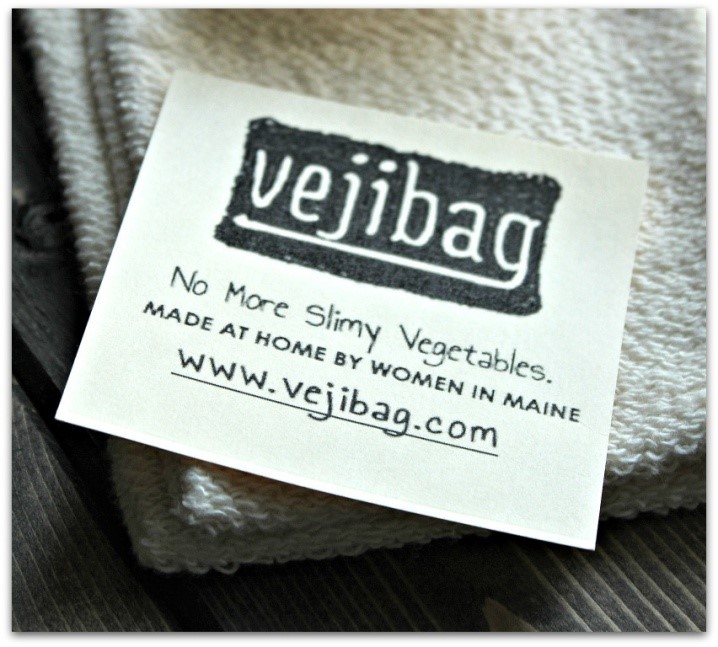
And so their motto emerged: Vejibag-No More Slimy Vegetables! And thus they began.
Since research shows that almost 25% of fresh produce gets thrown out, Sally and her partners knew they were truly on to something. They found that the Vejibag keeps all kinds of humidity-loving perishables fresh, crisp, and tasty for a well over a week.
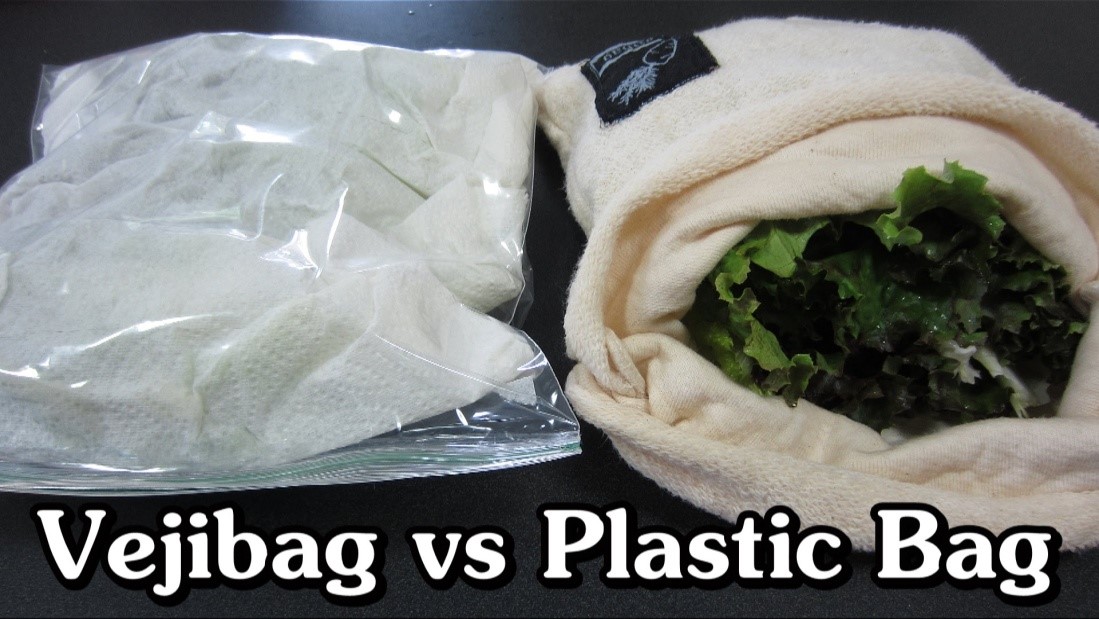
They did their own comparing experiments and consistently found that when stored in plastic, those same vegetables typically ended up as limp or slimy waste that they had to throw away.
They found over and over that damp cloth bags were keeping their moisture-loving vegetables moist and crisp in a high humidity environment. Here's how their bags work: Moisture slowly evaporates from the surface of the bag to keep both the bag and the vegetables "breathing." A slightly moist bag keeps vegetables crisp, several days beyond storage in either a crisper drawer or plastic bag.
While plastic bags and containers keep moisture in, they don't allow vegetables to breathe. This sets up an environment that promotes rotting. We've all picked through slimy spinach or pulled plastic bags from the crisper drawer that are full of limp carrots or yellowed broccoli. Vejibag prevents this type of rotting.
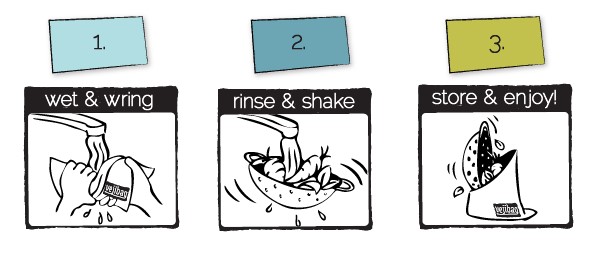
There are 3 steps to using the Vejibag:
1. Wet the bag and wring it so it's just damp. (NOTE: Sally says we'll want to wash our bag before we use it the first time.)
2. Then wash the vegetables and shake off all excess water. The Vejibag folks say there's no need to spin salad greens dry (I LOVE that direction-anything that saves me some time warms my heart).
3. Finally, place the freshly washed vegetables in the bag and store in the refrigerator. Keep the bag damp by sprinkling it every few days.
The Vejibag is 100% organic, undyed cotton that can be washed in cold or hot water. They just need to be turned inside out and laundered regularly. They can be dried either in the dryer or hung out on the line in the sun.
If you want to sanitize them thoroughly let them sit in 1/2 cup hydrogen peroxide and 1/8 cup of household vinegar for an hour.
If your bag gets stained you can remove the stain with an oxygen bleach or make your own environmentally friendly stain remover with 1/2 cup of 3% hydrogen peroxide and 2 tablespoons of Arm and Hammer Washing Soda. Add enough hot water to the hydrogen peroxide/washing soda solution to cover bag and let sit 24 hours.
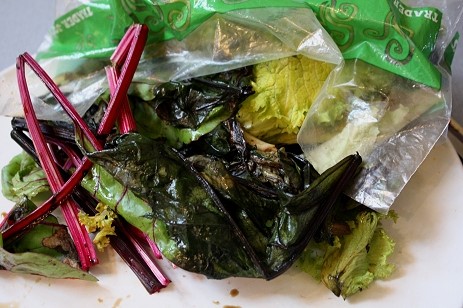
The more I read about these bags, the more enthused and convinced I am that this is the approach to no more slimy veggies. But I'm not the only one thinking this. Sally has shared loads of her bags with all sorts of people to test (MANY food website authors, cooks, neighbors, etc.) and the response is always the same-rave reviews.
And these reviews are validating because the bags are a little pricey. But every reviewer says their bags are paying for themselves over and over in the money saved by no more veggies going rotten. A typical testimonial:
"I bought some reduced-price greens (meaning the store thought they were ready to go slimy). I put them in my Vejibag. TWO WEEKS LATER-still fresh and crisp!" (Dana Reitman)
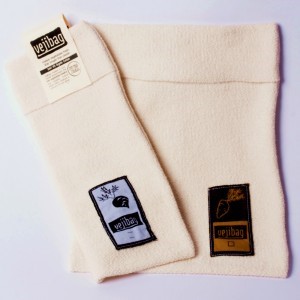
The cost and sizes of these French terry cloth bags with flip top closures? The 11"x12.5" bag is $17.95. The 11"x17" is $19.95 ( perfect for storing kale, chard, bok choy, celery, broccoli, etc.). In one month I've thrown away produce that cost more than these bags! There's an even bigger bag, the VegiChef (14"x17") for $23.95, that's especially useful to those who cook and eat a primarily vegetable diet.
It's a no-brainer for me, too. Helping women earn a living, supporting a USA cottage industry, and prolonging the life of my veggies-who wouldn't want to join in? Oh, and BTW: Vejibag offers a 30-day money-back guarantee on everything they sell. Interested also? Go to www.vejibag.com.
- www.vejibag.com
- www.indiegogo.com
- www.healthygirlskitchen.com
- www.geardiary.com
- www.youtube.com
- www.ironmom.blogspot.com
 Alice Osborne
Alice Osborne
Weekly Newsletter Contributor since 2006
Email the author! alice@dvo.com
